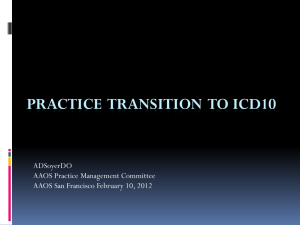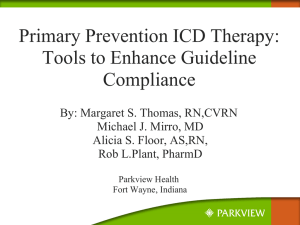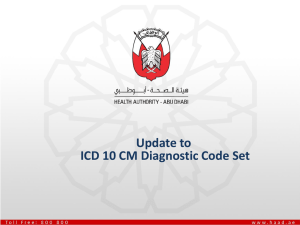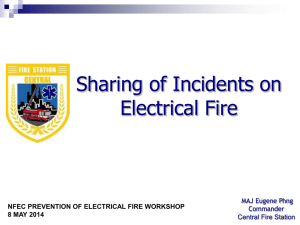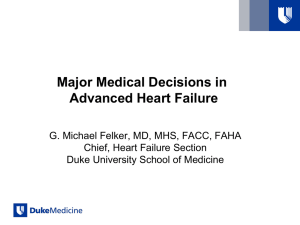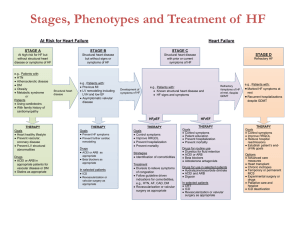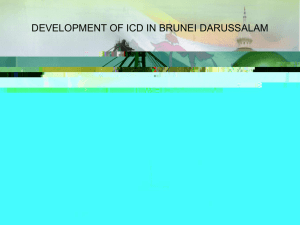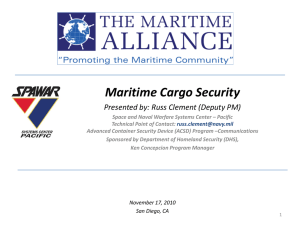EPO_Enhanced_ICD_IWG_26.v3 - Air Navigation Services
advertisement
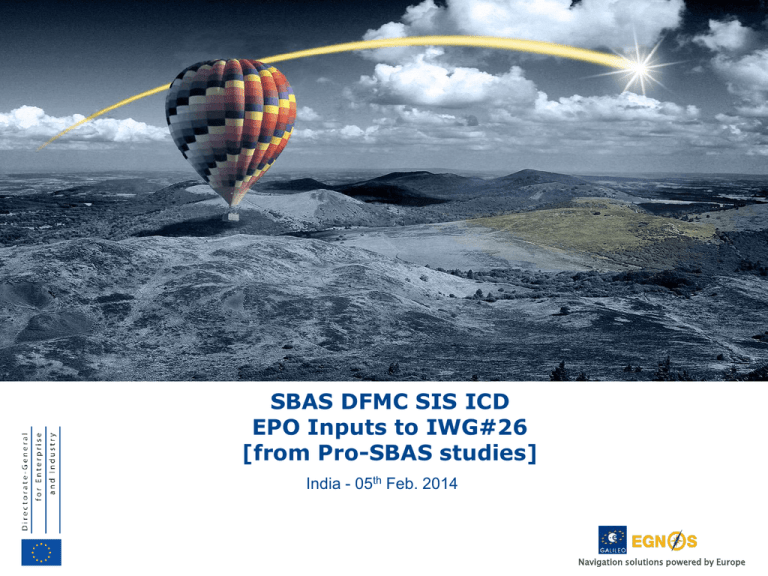
SBAS DFMC SIS ICD EPO Inputs to IWG#26 [from Pro-SBAS studies] India - 05th Feb. 2014 Navigation solutions powered by Europe Navigation solutions powered by Europe Reminder from IWG#25 Enhanced ICD Strategy Analysis Analysis of needs for enhanced ICD Definition of enhanced ICD Bandwidth Analysis Performance analysis • • • • Conclusion / possible way forward for SBAS DFMC ICD definition 17 January 2014 MSIL2 2 Reminder from IWG#25 Navigation solutions powered by Europe SBAS DFMC ICD1 o Derived from (existing) SBAS L1 legacy ICD o Capable of sustaining high DFRE dynamics o Limited to 51SV (DOP limitation).Dynamic mask improves but rather complex,possible safety issue,still DOP limitation o Possibility to extend to 91SV (altern. ICD with 2MT6+ general alert message), but necessitates to relax update rate (LTC) when >2 Const. Time To First Start impacted (wrt. MOPS L1 legacy) SBAS DFMC ICD2 o o o o 17 January 2014 Optimised (for bandwidth usage) Capable of up to 91SV with TTFF Simple to implement (System+User) Yet Rigid (max. 7 DFRE’s (possibly expandable to 8) update simultaneously in MTC, to repeat twice upon change) Imposes DFRE stability constraints on the System (with possible performance penalty) MSIL2 3 Reminder from IWG#25 Navigation solutions powered by Europe IWG#25 recommended to investigate possible unification of ICD1 and ICD2 in a unique and common (pre selected) “Enhanced ICD”, with an objective to gather the advantages of each of both ICD’s that is • ICD1 like flexibility (SBAS&GNSS performances)/reactivity upon asynchronous event • ICD2 like simplicity/BW efficiency/determinism IWG Technical SubGroup (Stanford, EPO/Pro-SBAS) met in ESTEC in Dec.2013 (as per IWG#25 recom.) The material which has fed this TSG is summarized in next slides, together with preliminary derivation of TSG meeting outcomes into a draft SBAS DFMC “Enhanced ICD” definition (working document) 9 April, 2015 PROSBAS 4 Enhanced ICD Strategy Analysis Navigation solutions powered by Europe IWG 25 Study of asynchronous events Best option for Enhanced ICD and of DFREI changes (IWG 26) Analysis of needs for enhanced ICD (WAAS, EGNOS, SDCM) MT C limited to 7 DRFEI updates => Need for new mechanism in case of more DFREI updates Definition of Enhanced ICD Introduction of new «MT 6 – like» messages Enhanced ICD Bandwidth Analysis Enhanced ICD Performance Analysis 17 January 2014 MSIL2 5 Analysis of needs for enhanced ICD : DFREI changes Navigation solutions powered by Europe Low variable DFREs Variable DFREs High variable DFREs Ex: WAAS Ex: EGNOS Ex: SDCM No need (tbc) for dynamic MT_6_1/2 mechanism. DFRE ICD Need for dynamic MT_6_1/2 mechanism. Enhanced ICD Need for MT_6_1/2 mechanism Num chan ges in 30sec wind ow More than 7 Percentage of events (%) 1 Cons 2 Cons 3 Cons 4 Cons (24 SVs) (48 SVs) (72 SVs) (91 SVs) 0 0.0 0.0 0.0 Num chan ges in 12sec wind ow More than 7 (more frequent usage than EGNOS case) Percentage of events (%) 1 Cons 2 Cons 3 Cons 4 Cons (24 SVs) (48 SVs) (72 SVs) (91 SVs) 0 0.034 0.116 0.197 Num chang es in 12sec windo w More than 7 Percentage of events (%) 1 Cons (24 SVs) 2 Cons (48 SVs) 3 Cons (72 SVs) 4 Cons (91 SVs) 4.845 15.239 34.164 50.232 T. Walter, J. Blanch and P. Enge (2013), “Implementation of the L5 SBAS MOPS”, IONGNSS 2013 Proceedings. 17 January 2014 MSIL2 7 Navigation solutions powered by Europe Extraction of the Histogram of the number of UDRE changes in a 12seconds window for 1 to 4 constellations (UDREs from EGNOS real data). 9 April, 2015 The European GNSS Programme 8 Analysis of needs for enhanced ICD: DFREI changes Navigation solutions powered by Europe Remarks Previous statistics do not discriminate between DFRE increase and decrease cases (e.g. if decrease, DFRE change may not be repeated through consecutive MTC) Capability to accommodate up to 8 DFREi’s (instead 7) is now proposed in new ICD draft (pending 6*4 bits preamble is baselined) Maintaining MTC for 18s (NPA Time-Out) upon DFREi change would increase the probability of update of > 7/8 DFREí 9 April, 2015 The European GNSS Programme 9 Proposed definition of enhanced ICD (MT6.1/6.2) Navigation solutions powered by Europe Principle : introduce ICD1 MT6 like messages (MT6.1, MT6.2) into ICD2, to improve DFRE update flexibility • • Up to 53 SV in mask (e.g. 24 GNSS1, 24 GNSS2, 5 Geos) o MT6.1 is used in place of MTC (no MTC), thus eliminating DFRE update constraints inherent to MTC o Handling of MT6.1 is similar to MT6 for SBAS L1 standard More than 53 SV in mask o MTC is mandatory. It is used for alerts o MTC format could be tailored to number of SV mask (allowing more than 7/8 DFREi in spare place) o MT6.1/MT6.2 can be used in complement to MTC in situations of multiple (>7/8) DFRE update, to minimize user impacts o Handling of MT6.1/MT6.2 : see next slides In terms of implementation • • Introduction of MT6.1/MT6.2 should not deeply affect the foundations/basic mechanisms, nor the simplicity of ICD2 Moreover MT6.1/MT6.2 could be SBAS optional mechanism 17 January 2014 MSIL2 10 Proposed definition of enhanced ICD - Messages Navigation solutions powered by Europe 9 April, 2015 The European GNSS Programme 11 Proposed definition of enhanced ICD (MT6.1/6.2) Navigation solutions powered by Europe MT6.1/6.2 dynamic mechanism (when more than 53 SV) • System computes DFREIs each epoch and checks all SVs in mask, if DFREI has changed with respect to any previously broadcast DFREi that is still valid (12 s or 18 s (TBC)) • A change in DFREI for each individual satellite with MTC is maintained during 12 s (i.e. timeout of the integrity in PA) NB: The case of NPA users (with an integrity timeout of 18 seconds) should be discussed • If the System detects that more than 7(or 8) DFREIs have to be changed, then MT6.1/6.2 mechanism can be activated in place of MTC, thus mitigating user performance impact 17 January 2014 MSIL2 13 Proposed definition of enhanced ICD (MT6.1/6.2) Navigation solutions powered by Europe More than 53 SVs in mask: MT6.1 & MT6.2 No Alarm, first case • System detects change of more than 7 DFREIs at epoch when MT_C is not to be broadcast - > MTC substituted by MT6.1 & 6.2 • Robust upon message loss: Unchanged DFRECIs and Changed DFREI sent two times within 12 s (or 18 s - TBC). If both information are lost, receiver sets the SV to Not Monitored 17 January 2014 MSIL2 14 Proposed definition of enhanced ICD (MT6.1/6.2) Navigation solutions powered by Europe More than 53 SVs in maks: MT6.1 & MT6.2 No Alarm, second case • • • • System detects more than 7 DFREI changes at epoch when MT_C is to be broadcast MTC is substituted by MT6.1 and next epoch, MT6.2 is broadcast. (To be discussed) Even if MT6.2 is sent 7 epochs after the previous MTC, it is ensured to send the integrity of all SVs twice in 12 s since another MT6.1 is sent the epoch before next MTC and this MTC is substituted by MT6.2. This mechanism avoids loss of service that could be induced by MTC broadcast instead of MT6.1/6.2. (Alternatively) MTC could be sent in priority after 6s. 17 January 2014 MSIL2 15 Proposed definition of enhanced ICD Robustness upon message loss Navigation solutions powered by Europe Robustness upon integrity message loss: • MT_C: o Non-alarm MT_C lost without DFREI change: robustness ensured due to 12 sec DFREI timeout (PA) o Non-alarm MT_C lost with DFREI changes: robustness ensured since DFREI change maintained during 12 sec. It is ensured that numerical changing DFREIs are sent twice in 12 sec. If both messages are lost, the receiver will have the DFREI timed-out and the corresponding SV would be set internally to Not Monitored • MT_6_1/2: It is ensured that the new DFREI values are sent twice in 12 sec Robustness upon alarm + message loss: As in an alarm situation, MT_C is sent 4 consecutive times, robustness upon message loss is ensured Additionally, the System will be in charge of computing any possibility for a receiver to have misleading information, due to any possible valid message loss combination. In case this happens, the System shall send the corresponding 4 consecutive MT_C alarm messages Robustness upon loss of other messages : OBAD(MTD), IOD mechanisms 17 January 2014 MSIL2 16 Bandwidth Analysis - Scenarios Navigation solutions powered by Europe Different scenarios have been prepared for Enhanced ICD Bandwidth analysis, extrapolation of the linear fit analysis and VPL performances analyis. Main difference between scenarios • variable MTD update rate to increase BW margins (e.g. to be capable to adapt to SBAS with variable DFRE dynamics, to tune BW margins (e.g. for additionnal parameters (e.g. iono for L5 back-up), alarms)). • TTFS impact to be assessed 17 January 2014 MSIL2 17 Bandwidth Analysis - Scenarios Navigation solutions powered by Europe 1st Set of simulations • Time-to-first-start limit (SBAS L1 legacy like) => Messages update interval imposed at 120 s (incl. for MT D), except integrity (MT C) and iono. (MT 18, 26, 30) messages • Up to 100% bandwidth could be used with a deterministic behavior • Scheduler algorithm should not be constrained by standardization (SBAS System dependent). Simplicity of Enhanced ICD allows non-deterministic scheduler with deterministic behavior • Simulations limited to SBAS with Low Variable DFREs (WAAS like) and Variable DFRE (EGNOS like) 2nd Set of simulations • No a priori time-to-first-start (i.e. relaxed compared to L1 Legacy) • Compute MT_D Update Intervals for leaving 15% free bandwidth • Simulations for any type of SBAS (incl. With high dynamic DFRE like SDCM) 17 January 2014 MSIL2 18 Bandwidth Analysis Navigation solutions powered by Europe First Set of simulations (Enhanced ICD) Objective: compute bandwidth usage for complying with time-tofirst-start (TTFS). NB: BW budget could be refined to account for MT_E at higher rate (e.g.60s) and relaxed MT_F, MT_G or MT_H NoIono Result: Bandwidth usage not larger than 100% in NoIono case even for 4 constellations 17 January 2014 MSIL2 20 Bandwidth Analysis Navigation solutions powered by Europe First Set of simulations (Enhanced ICD) Iono ECAC Result: Bandwidth usage larger than 100% in Iono ECAC in 4 const. case Iono ECAC+AFI Result: BW usage > 100% in Iono ECAC+AFI for 3 and 4 const. L5-only back-up cannot be implemented unless TTFS constraint is relaxed. 17 January 2014 MSIL2 21 Bandwidth analysis Navigation solutions powered by Europe Second Set of simulations Objective: to compute message update rates for 85% bandwidth usager (relaxing MTD UR) No Iono Iono ECAC Iono ECAC+AFI 17 January 2014 MSIL2 22 Bandwidth analysis Navigation solutions powered by Europe Summary of the results (for 85 % bandwidth) Number Const. 17 January 2014 MT_D Update Interval (in seconds) NoIono ECAC ECAC+AFI 1 Const. 40 47 53 2 Const. 79 94 107 3 Const. 119 143 163 4 Const. 151 181 207 MSIL2 23 Performance analysis Extrapolation of the linear fit Navigation solutions powered by Europe Enhanced ICD: linear clock model - At IWG #25, it was shown that linear clock model is a better method for clock estimation than RRC method used in UDRE Alternative ICD. - In present analysis of extrapolation of the linear fit in Enhanced ICD, it is assumed GPS-like clock performances. - Glonass SV clocks have been also been studied (IWG 25) showing larger Delta_FC values with respect to GPS SVs with a factor ~2. 17 January 2014 MSIL2 24 Performance analysis Extrapolation of the linear fit Navigation solutions powered by Europe Analysis on extrapolation of the linear fit has been performed for Enhanced ICD using as input MT_D Update Intervals computed in bandwidth analysis No Iono Model Regime Optimistic DeltaT_ FC (sec) Sigma_ Delta _F C (m) 40 0,0906 79 0,1077 119 0,1245 151 Enhanced ICD Nominal Pessimistic 17 January 2014 Model Regime Optimistic 0,1331 40 0,1258 79 0,1511 119 0,1756 151 0,1906 40 0,1534 79 0,1991 119 0,2441 151 Iono ECAC+AFI Iono ECAC 0,2685 Enhanced ICD Nominal Pessimistic DeltaT_ FC (sec) Sigma_ Delta _F C (m) 47 0,0943 94 0,1140 143 0,1310 181 47 94 143 181 47 94 143 0,1416 0,1315 0,1603 0,1869 0,2034 0,1631 0,2160 0,2625 181 0,2858 Model Regime Optimistic Enhanced ICD Nominal Pessimistic DeltaT_ FC (sec) Sigma_ Delta _F C (m) 53 0,0968 107 0,1195 163 0,1363 207 53 107 163 207 53 107 163 0,1492 0,1352 0,1682 0,1962 0,2140 0,1698 0,2307 0,2767 207 0,2988 MSIL2 25 Performance analysis Estimation of VPL Performances Navigation solutions powered by Europe Same model as presented at IWG#25 has been used for VPL performances VPL mean, minimum and maximum values have been computed from DeltaT_FC and DeltaT_IP for all the Scenarios 17 January 2014 MSIL2 26 Performance analysis Estimation of VPL Performances Navigation solutions powered by Europe Performance of «enhanced ICD» are equivalent to those of ICD2 (i.e. improves up to 4 const., despite MTD update rate relaxation) VAL values around 10-15m can be targeted with enhanced ICD for ≥ 2 const. (tbc with more refined model) 17 January 2014 MSIL2 33 Performance analysis Estimation of VPL Performances / mission targets Navigation solutions powered by Europe PRELIMINARY ASSESSMENT OF ENHANCED ICD BASED ON MAXIMUM VPL VALUES Constellations GPS GPS+GAL GPS+GAL+GLO GPS+GAL+ GLO+COMP LPV-200 (35 m) CAT I auto. (15m) CAT-I auto (10 m) VPL performance with Enhanced ICD (from preliminary simulations) LPV-200 VAL=35m always achievable Cat I VAL=15m necessitates at least 2 constellations in the SBAS System. Cat I VAL=10m limit seems possible target (tbc) with ≥2 const. (yet more refined performance model should be built); better margins with 3 or 4 const. More demanding missions (e.g. Cat II), if targetable, would necessitate fine tuning (e.g. DFRE scaling) and possible complementary features (e.g. receiver DRAIM for TTA) 17 January 2014 MSIL2 34 Conclusion / possible way forward for ICD definition Navigation solutions powered by Europe ICD1 and ICD2 can actually be unified through “Enhanced ICD”, which provide the advantage of both (w/o their inherent constraints and/or limitations) and discarding some drawbacks • Performance could be optimised towards demanding VAL’s (in the range of 10m, and possibly less (TBC)) • SBAS MOPS L1 legacy TTFS can be met (providing L5 iono BU with ARAIM or SBAS NPA, not with SBAS PA) without imposing system design constraint (e.g. MT_D broadcast only when SV visible) • Possibility to handle dynamic DFRE situations (>7/8 simultaneous update) thus mitigating user penalty and enabling fast recovery (e.g. upon general constellation alert, SNT instability etc.) • Robustness (e.g. upon message loss) • Simplicity very close to ICD2 for system + user (yet to be consolidated with user manufacturers); much simpler than ICD1 ( 9 April, 2015 PROSBAS 35 Conclusion / possible way forward for ICD definition Navigation solutions powered by Europe Draft “Enhanced ICD” has been derived for EGEP internal usage (HISTB/NISTB) capitalising on JASMIN/PRO-SBAS material and gathering comments (collected along Dec.2013/Jan 2014) from Stanford, MITRE, GMV Pro-SBAS, EGNOS V3 Industry and CNES Pending further consolidation loop with IWG partners (after IWG#26), this draft “Enhanced ICD” could serve as first step towards SBAS DFMC ICD definition 9 April, 2015 The European GNSS Programme 36
